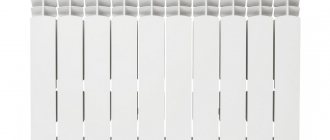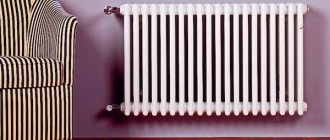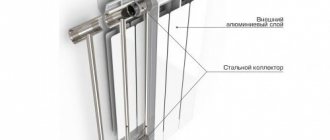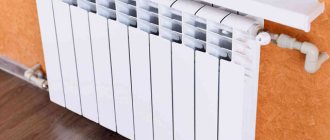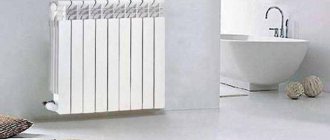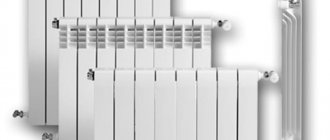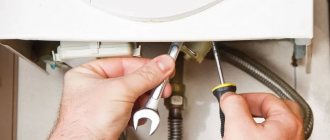| Many homeowners believe that if a bimetallic radiator is hot on top and cold on the bottom, then there is no need to worry. This is partly true. Due to the increased heat transfer of the bimetal, the coolant can cool down a little while passing through the circuit, so the owners notice a slight temperature difference in different parts of the battery. |
However, a significant temperature variation may indicate problems in the heating system that should be corrected. If you ignore breakdowns, this can lead to various problems:
- decrease in indoor air temperature;
- increased heating costs;
- rapid failure of the radiator.
There are not many reasons that could lead to poor heating of a bimetallic battery. Most often, it cools down due to blockages, air locks, impaired coolant circulation, faulty shut-off valves or improper installation.
Air jams
A common reason for poor heating of a bimetallic battery is airing of the system, which is associated with the accumulation of air bubbles inside the radiator. To avoid the formation of an air lock, a Mayevsky valve is installed on the line, which allows air to be periodically released manually or automatically. To activate the release of air masses, the manual valve is opened with a key or a screwdriver. Automatic models are equipped with a float, which automatically lowers when air accumulates and allows it to escape to the outside.
Insufficient boiler power
If the radiators in a private house do not heat well, then one of the reasons may lie in the heating boiler. In your home, you can say with almost 100% probability that the heating circuit is autonomous. So the boiler is standing. It could be:
Why do batteries heat poorly in a private home? The reason may be an incorrectly selected boiler power. That is, it does not have enough resources to heat the required amount of liquid. The first sign that the power has been selected incorrectly is the constant operation of the heating device, without shutdowns.
Although in this case the heat exchangers will heat up at least a little. And if the water in them is completely cold, it means that the boiler is broken or cannot turn on. Modern units have a minimum pressure requirement in the system. If this requirement is not met, it will not turn on. In addition, there is an automation and security system.
Let's take, for example, a gas boiler. It contains a sensor that monitors that all gases go into the chimney. It is possible that the chimney or some smoke outlet pipe is clogged. In any case, the sensor will send a command to the control unit and it will not allow the boiler to turn on.
Here you will find information on how to repair a heating radiator with your own hands.
Radiator clogged
Often the problem of poor-quality heating is associated with contaminated coolant, which may contain rust, sand and other impurities. Under the influence of high temperatures, they form a coating on the inner surface of the radiator, which prevents normal water circulation. Plaque is able to absorb heat and reduce the volume of coolant passing through the system, so the battery begins to cool.
The way out of the situation is to clean the line, which can be done in various ways:
- mechanical;
- chemical;
- hydrodynamic;
- hydropneumatic.
The easiest way to flush is with special chemicals that can break down deposits and wash away dirt. To avoid this problem again, preventative cleaning should be performed annually, and general cleaning every 5-7 years.
A drastic measure is replacing heating batteries
Unfortunately, old radiators that have been heating your home for decades can no longer be brought back to life by flushing. If, even after general internal cleaning, the batteries remain cold when the riser heats up, they will have to be mercilessly replaced with new ones. Radiators made of stainless steel or chrome-plated are ideal for the bathroom. When purchasing a painted radiator, you should take into account the quality of paint application - in conditions of high humidity it must be impeccable.
A new radiator will solve the problem of insufficient heating
Aluminum heat exchangers have low operating pressure, so they are not recommended for installation in apartments located above the 8th floor. In addition to this drawback, they have another significant drawback - the inner surface of these products is susceptible to corrosion, so you should not expect long years of service from them.
Radiators with towel hangers are produced especially for bathrooms. They not only perform their main function, but also allow you to neatly hang towels for quick drying. To decorate your bathroom, you can choose unusual radiators, which are now easy to find.
Replacing radiators is a complex and time-consuming process that is best left to professionals. Naturally, major repairs should be planned for the season when the heating in the house is turned off.
Incorrect connection
If you connect the radiator incorrectly, this can lead to a drastic reduction in the heating efficiency of the room. As a rule, such mistakes are made by self-taught people, so it is better to hire professionals for installation. Otherwise, this may lead to the following problems:
- decrease in battery efficiency;
- change in the process of circulation and outflow of coolant;
- increased risk of corrosion.
If the radiator was connected incorrectly, the coolant penetrates into it through the lower pipe, then circulates in a circle and flows out of the battery. As a result, not all sections are heated, which negatively affects heating. When the coolant enters the heating device, it immediately rushes upward, since hot water has a higher density than cold water. As a result, the liquid travels the shortest possible path, warming up not every section. The problem can only be solved by dismantling the radiator and proper installation.
Additional reasons
Cases when the temperature in the apartment is low are not so rare.
The coolant may simply not reach the last radiator along the route. This may be relevant when the system is incorrectly designed, or the diameter of the pipes does not correspond to the calculated one. Quite often the ratio of water volume to intensity and circulation is selected incorrectly. If you still don’t know what to do if the batteries don’t heat well, then it’s also important to pay attention to whether the pump is doing its job. A change in the heating operating temperature can be caused by a number of internal reasons. Many of them negatively affect the efficiency of the system, increasing energy costs
In such cases, a reasonable question arises: why does the heating not heat up: radiators, batteries, pumps, systems? The first step is to find the causes of the problem.
Many of them negatively affect the efficiency of the system, increasing energy costs. In such cases, a reasonable question arises - why does the heating not heat up: radiators, batteries, pumps, systems? The first step is to find the causes of the problem.
A change in the heating operating temperature can be caused by a number of internal reasons. Many of them negatively affect the efficiency of the system, increasing energy costs. In such cases, a reasonable question arises: why does the heating not heat up: radiators, batteries, pumps, systems? The first step is to find the causes of the problem.
Breakdowns of shut-off valves
Shut-off valves include cone valve, thermal head, ball valve. The main purpose of these devices is regulation, partial and complete shutoff of the coolant. If they malfunction, the water circulation in the system is disrupted, since a broken faucet or valve stops letting liquid through even in the open position. The only way to deal with a breakdown is to completely replace the failed device.
To avoid problems with the start of the heating season, it is recommended to conduct a thorough inspection of the line before turning on the heating. It is important to check in advance for the presence of excess air and bleed it if necessary, inspect the shut-off valves for faults, and determine the functionality of the circulation pump. If you carefully prepare the system, bimetallic radiators will work properly throughout the entire heating period.
Independent solution to the problem of cold batteries
If you decide to act on your own, then you can think about what problem could lead to the low temperature of the radiator. The most common case is air locks. If the house has the latest generation of radiators, they must be equipped with a hole for air removal. It is usually installed at the top of the battery, since air accumulates there.
If you turn the tap clockwise, you will hear a characteristic hissing sound. Once water begins to seep out, the tap can be closed. In order to make sure that the air has completely escaped, even after water has seeped out, you can keep the tap half-open, since air currents can escape with the liquid.
If the radiators in the apartment do not heat well, it is, of course, important to decide what to do. Experts say that it is not worth reducing the volume of water in the radiator for a long time; it will be more effective to open the tap after a while
This will allow the water and air to restart.
Where to contact
- Call the control room of the management company (MC) servicing your home. You can find its number in payment documents or on the information board at home. Check to see if any technical work is currently being carried out.
- If not, you should contact your neighbors in the riser; perhaps they have closed the circuit for repairs.
- If you are sure that the reason does not lie in your house or apartment, and the temperature is below the established standards, you have the right to call an engineer from the management company to draw up a report and eliminate the reasons.
Illiterate arrangement of an autonomous heating system
When arranging heating in your home, the question often arises as to why the last radiators in a two-pipe system are cold.
Why do batteries heat poorly in a private home?
In this case, the batteries may be cold from below, when the “return” and “supply” have been confused, or the coolant circulation rate inside the devices is not high enough.
- In the first case, everything is simple. The battery was incorrectly connected to the supply and return pipes of the heating system. Here it is enough to disconnect the radiator and connect it correctly, according to the heating diagram.
- When the radiator is hot at the top and cold at the bottom in the second case, it is explained as follows. When the coolant flows through the system at high speed, its elements will be hot everywhere. When the speed is low, the water gradually cools and becomes colder at the bottom of the radiators.
Insufficient coolant circulation
Insufficient coolant velocity occurs in such cases.
- When the internal diameter of the pipe is narrowed in any area.
- When the flow rate of the coolant is not high enough in principle.
A common reason for slow water movement is a low-power or faulty circulation pump. In the case of a gravity (gravity) heating network, it does not exist at all.
The internal cross-section of the pipes may unexpectedly decrease in such cases.
- Incorrect choice of control valve, with a narrowed inner diameter.
- Poor-quality soldering of plastic pipes, when internal sagging and burrs appear at the points of their connection.
- Deposits on the walls of pipes that do not allow the possible volume of coolant to pass through and slow down its flow (hydraulic resistance).
There is another situation when the bottom of the radiator is cold and the top is hot. This is when the room is not insulated (for example, a cold balcony, veranda). If the air temperature in the room is low, then the coolant in the radiator will cool faster.
When the upper battery pipe is heated and the lower one is cold, then the “return” and “supply” are not confused. Therefore, valves and pipes should be checked.
- If the battery has an adjustment valve, it is worth twisting it and checking it. If you find that its internal diameter is too narrow, you will need to install a valve with a sufficient flow area.
- When the heating pipes themselves have too small an internal diameter or their walls are clogged with deposits, there is nothing left to do but change them.
- There is another way out - install . However, this solution is not entirely correct, and its price is high.
